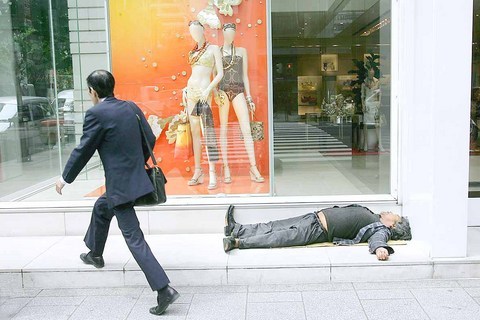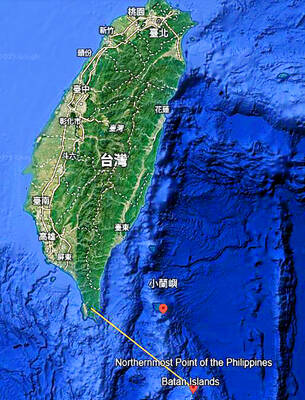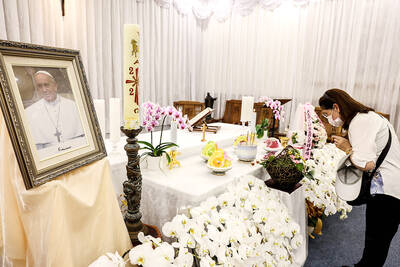Japan's economy is headed for its longest post-war expansion but away from the thronging shopping malls, new skyscrapers and luxury condominiums, many elderly and unemployed complain of losing out.
Kurumada, 72, who declined to give his first name, says he can only afford two meals a day with his welfare payment of ?96,000 (US$870) per month from the government, which also subsidizes his rent.
"I feel I just survive. I don't feel I'm living a life," said the former blue-collar worker, who began receiving benefits four years ago after heart disease forced him to give up his job fixing electric equipment.

PHOTO: EPA
Before he earned up to ?5 million, or about US$45,000, a year.
"Now I can't afford three meals a day," he said with rueful smile in his small one-room apartment in Arakawa ward in the old area of Tokyo.
Elsewhere in the capital, 71-year-old Kimiko Kimura has to make do with no bath or shower.
"There is no room equipped with a bath available at a cheap enough rent in Tokyo," said Kimura, who ran a small polystyrene business north of the city until her husband's death.
These are not extraordinary cases in Japan, which has prided itself since the end of World War II on being a classless society. Even today people in need are often reluctant to ask for help.
"In Japan, poor people hide. Those who live on social security don't talk about it because they think they are responsible for their own misfortune," said Kazuya Hata, a charity worker at The Group to Protect Living and Health.
Homelessness, which was largely unknown in Japan until the economic bubble burst in the early 1990s, has also risen and many parks are dotted with the blue tarpaulins of their makeshift shelters.
Japan's economy may be finally emerging from the `lost decade' of deflation but it is still expected to have more than one million households on welfare on average in the year to March, according to the most recent government survey.
This is about 2 percent of the total number of households in Japan and a 60 percent jump from 10 years ago, according to the Ministry of Health, Welfare and Labor.
While the increase is largely due to the aging population, the total number of working-age people on welfare, including disability and other benefits, has also gone up.
Almost 20 percent of the Japanese population is now aged 65 or older.
This ratio, already at a record high, will only increase as post-war baby boomers approach retirement age, while the falling birthrate is set to put increasing strains on the public finances.
While some struggle to scrape by, those with cash to burn head for ultra-chic shopping complexes in Tokyo with jaw-dropping prices, such as Roppongi Hills and its new sister mall Omotesando Hills.
Social inequalities may still be less pronounced in Japan than many other countries but there is increasing public concern about the emergence of the "haves" and the "have-nots" -- and the rising number of Japanese millionaires.
For many Japanese the unsavory side of the country's new style of capitalism was embodied by the fall from grace of Takafumi Horie, the high-flying founder of the Livedoor Internet firm now indicted for fraud.
A poll in March by the Yomiuri newspaper found that some 81 percent of Japanese people think the income gap is widening and many blame Prime Minister Junichiro Koizumi's reforms as he seeks to slim down the government.
According to the Organization for Economic Co-operation and Development (OECD), Japan's gini coefficient, a leading measure of inequality, stood at 0.314 in 2004, worse than Germany, France and Scandinavian nations but better than the US and Britain.
In 1969 Japan's gini coefficient was 0.316, above France's 0.414 at around the same time, where zero corresponds to perfect equality and 1.0 to perfect inequality.
On the face of it Japan's economy is in the best shape for a long time with the unemployment rate is at a seven-year low of 4.1 percent.
The number of people receiving jobless benefits declined to 628,000 in the fiscal year to March this year from 1.1 million four years earlier, out of a total population of about 127 million, according to government statistics.
However, not everyone is benefiting from falling unemployment, said Takuro Morinaga, an economics professor at Dokkyo University near Tokyo.
"Many specialists say the income gap has been rapidly widening," he said, noting that under Koizumi's reforms it has become easier for manufacturing companies to hire temporary workers.
"This means that many workers who used to be protected by the law can suddenly be fired, even though they are on lower incomes," Morinaga added.

SECURITY: As China is ‘reshaping’ Hong Kong’s population, Taiwan must raise the eligibility threshold for applications from Hong Kongers, Chiu Chui-cheng said When Hong Kong and Macau citizens apply for residency in Taiwan, it would be under a new category that includes a “national security observation period,” Mainland Affairs Council (MAC) Minister Chiu Chui-cheng (邱垂正) said yesterday. President William Lai (賴清德) on March 13 announced 17 strategies to counter China’s aggression toward Taiwan, including incorporating national security considerations into the review process for residency applications from Hong Kong and Macau citizens. The situation in Hong Kong is constantly changing, Chiu said to media yesterday on the sidelines of the Taipei Technology Run hosted by the Taipei Neihu Technology Park Development Association. With

CARROT AND STICK: While unrelenting in its military threats, China attracted nearly 40,000 Taiwanese to over 400 business events last year Nearly 40,000 Taiwanese last year joined industry events in China, such as conferences and trade fairs, supported by the Chinese government, a study showed yesterday, as Beijing ramps up a charm offensive toward Taipei alongside military pressure. China has long taken a carrot-and-stick approach to Taiwan, threatening it with the prospect of military action while reaching out to those it believes are amenable to Beijing’s point of view. Taiwanese security officials are wary of what they see as Beijing’s influence campaigns to sway public opinion after Taipei and Beijing gradually resumed travel links halted by the COVID-19 pandemic, but the scale of

A US Marine Corps regiment equipped with Naval Strike Missiles (NSM) is set to participate in the upcoming Balikatan 25 exercise in the Luzon Strait, marking the system’s first-ever deployment in the Philippines. US and Philippine officials have separately confirmed that the Navy Marine Expeditionary Ship Interdiction System (NMESIS) — the mobile launch platform for the Naval Strike Missile — would take part in the joint exercise. The missiles are being deployed to “a strategic first island chain chokepoint” in the waters between Taiwan proper and the Philippines, US-based Naval News reported. “The Luzon Strait and Bashi Channel represent a critical access

Pope Francis is be laid to rest on Saturday after lying in state for three days in St Peter’s Basilica, where the faithful are expected to flock to pay their respects to history’s first Latin American pontiff. The cardinals met yesterday in the Vatican’s synod hall to chart the next steps before a conclave begins to choose Francis’ successor, as condolences poured in from around the world. According to current norms, the conclave must begin between May 5 and 10. The cardinals set the funeral for Saturday at 10am in St Peter’s Square, to be celebrated by the dean of the College